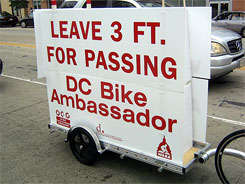Three Feet to Pass Laws

Some bike collisions are the result of vehicles and bicyclists being too close together. Motorists might be unaware that all of our local jurisdictions–Washington, DC, Virginia, and Maryland–have laws requiring a 3 foot minimum distance between the vehicle and bicyclist when passing. This means that a bicyclist should not be able to reach out and touch the vehicle. If there is not sufficient room to leave three feet of space, a motorist should not pass a bicyclist in the roadway.
These 3 foot laws really highlight the psychological barrier most drivers have to treating bicyclists as equals on the roadway. For example, if you are driving behind a slow-moving vehicle, you may be annoyed, but you probably realize that you must follow behind the slow-moving car until it is safe to pass it by. It should be no different when a vehicle comes up behind a bicyclist riding in the roadway. Yet many motorists coming up from behind a bicyclist will instead feel that they can pass the bicyclist in the bicyclist’s lane, or that the bicyclist needs to move off the roadway to let the vehicle pass. However, neither is true. It is the motorist’s duty to make sure that there is sufficient space to pass a bicyclist. Some lanes are wide enough to allow a bicylist and vehicle to drive side-by-side with 3 feet between them. But in a lot of our urban areas–places like downtown DC, Arlington, Alexandria, and Bethesda–the lanes are often not wide enough for same-lane passing. Violation of our “3 feet” laws are common and many police officers and witnesses do not automatically recognize the driver’s failure to follow the rules of the road after a collision. Again, this is a common situation where an experienced bike lawyer can help.
